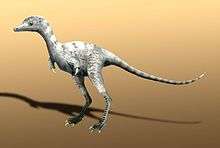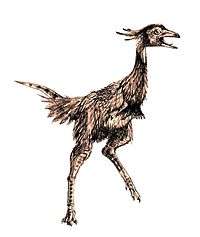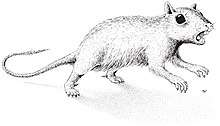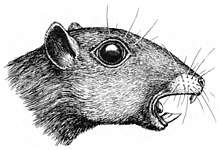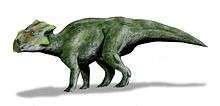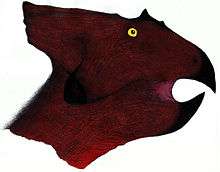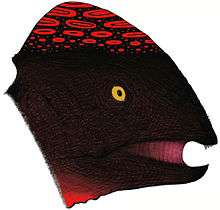Barun Goyot Formation
The Barun Goyot Formation or Baruun Goyot Formation (West Goyot Formation) is a geological formation dating to the Late Cretaceous Period. It is located within and is widely represented in the Gobi Desert Basin, in the Ömnögovi Province of Mongolia.
| Barun Goyot Formation Stratigraphic range: Maastrichtian ~72–71 Ma | |
|---|---|
| Type | Geological formation |
| Underlies | Nemegt Formation |
| Overlies | Djadokhta Formation |
| Thickness | ca. 110 m (360 ft) |
| Lithology | |
| Primary | Sandstone |
| Location | |
| Coordinates | 43.5°N 99.8°E |
| Approximate paleocoordinates | 40.5°N 89.5°E |
| Region | Omnogov |
| Country | |
| Extent | Gobi Desert |
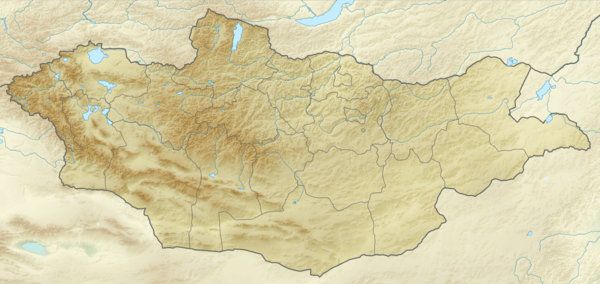 Barun Goyot Formation (Mongolia) | |
Description
It was previously known as the "Lower Nemegt Beds" occurring beneath the Nemegt Formation and above the Djadokhta Formation. It has been suggested that the Djadokhta and Barun Goyot Formations are lower and upper parts, respectively, of the same lithological unit and the boundary between the two does not exist. The stratotype of the Barun Goyot Formation is the Khulsan locality, east of Nemegt. At Nemegt, only the uppermost barungoyotian beds are visible. The Red Beds of Khermeen Tsav are also considered part of the Barun Goyot Formation. It is approximately 110 metres (360 ft) in thickness,[1] and was laid down roughly 72-71 million years ago. Given the new date for the start of the Maastrichtian (72.1 MYA) a basal Maastrichtian age seems probable. The Barun Goyot Formation preserves an environment of sand dunes, created from wind-eroded rocks (aeolian dunes).
Vertebrate paleofauna
Saurischians
| Genus | Species | Location | Material | Notes | Images |
|---|---|---|---|---|---|
|
H. yanshini |
|
An oviraptorid originally called Ajancingenia |
| ||
|
Indeterminate |
|
An avimimid similar to Avimimus portentosus from the Nemegt Formation |
| ||
|
C. oculatus |
|
An alvarezsaurid. |
|||
|
G. minuta |
"Embryonic skulls and skeletons."[3] |
An enantiornithine. |
|||
|
Hollanda |
H. luceria |
||||
|
H. perlei |
"Partial foot."[4] |
||||
|
Indeterminate |
|
||||
|
Oviraptorinae indet.[2] |
Indeterminate |
|
An oviraptorid |
||
|
P. remotus |
|
"Partial postcranial skeleton."[5] |
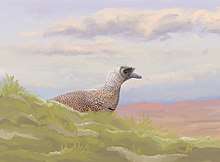 | ||
|
Sauropoda indet. |
Indeterminate |
|
|||
|
T. bataar?[6] |
A tyrannosaurid; may actually be from the Nemegt Formation.[6] |
||||
|
Velociraptorinae indet.[2] |
Indeterminate |
||||
Lizards
| Genus | Species | Location | Stratigraphic position | Abundance | Notes | Images |
|---|---|---|---|---|---|---|
|
Estesia mongoliensis |
An anguimorph |
|||||
|
Ovoo gurvel |
||||||
|
Proplatynotia longirostrata |
||||||
|
Gobiderma pulchrum |
A Monstersaur |
|||||
Mammals
| Genus | Species | Location | Stratigraphic position | Abundance | Notes | Images |
|---|---|---|---|---|---|---|
|
Asiatherium |
Asiatherium reshetovi |
A metatherian. | ||||
|
Asioryctes |
Asioryctes nemegetensis |
A eutherian. |
||||
|
Barunlestes |
Barunlestes butleri |
A eutherian |
||||
|
Catopsbaatar catopsaloides |
A multituberculate |
|||||
|
Chulsanbaatar vulgaris |
A multituberculate |
|||||
|
Deltatheridium pretrituberculare |
A metatherian |
|||||
|
Nemegtbaatar gobiensis |
A multituberculate | |||||
|
Zofialestes |
Z. longidens |
A eutherian related to Zalambdalestes | ||||
Ornithischians
| Genus | Species | Location | Material | Notes | Images |
|---|---|---|---|---|---|
|
B. rozhdestvenskyi |
"[Five] complete skulls, [twenty] fragmentary skulls, postcranial skeletons, juvenile to adult."[7] |
A ceratopsian. |
| ||
|
Breviceratops kozlowskii |
A ceratopsian. | ||||
|
Lamaceratops tereschenkoi |
A ceratopsian. | ||||
|
Platyceratops tatarinovi |
A ceratopsian. | ||||
|
S. chulsanensis |
"."[8] |
An ankylosaur. | |||
|
T. kielanae |
|
An ankylosaur. | |||
|
T. gilmorei |
|
||||
|
Z. nomadis |
|
An ankylosaur. | |||
Eggs
| Oogenus | Oospecies | Location | Material | Notes |
|---|---|---|---|---|
|
S. sabathi |
|
Probably avian | ||
|
F. ningxiaensis |
|
Possibly sauropod eggs |
See also
- List of dinosaur-bearing rock formations
- List of fossil sites (with link directory)
References
- Gradzinski, R.; & Jerzykiewicz, T. (1974). Sedimentation of the Barun Goyot formation. Palaeontologica Polonica, 30, 111-146.
- Nicholas R. Longrich; Philip J. Currie; Dong Zhi-Ming (2010). "A new oviraptorid (Dinosauria: Theropoda) from the Upper Cretaceous of Bayan Mandahu, Inner Mongolia". Palaeontology. 53 (5): 945–960. doi:10.1111/j.1475-4983.2010.00968.x.
- "Table 11.1," in Weishampel, et al. (2004). Page 213.
- "Table 10.1," in Weishampel, et al. (2004). Page 199.
- "Table 11.1," in Weishampel, et al. (2004). Page 211.
- Mortimer, M (2004). "Tyrannosauroidea". The Theropod Database. Archived from the original on 2013-09-29. Retrieved 2007-08-21.
- "Table 22.1," in Weishampel, et al. (2004). Page 479.
- "Table 17.1," in Weishampel, et al. (2004). Page 364.
- Arbour, V. M., Currie, P. J. and Badamgarav, D. (2014), "The ankylosaurid dinosaurs of the Upper Cretaceous Baruungoyot and Nemegt formations of Mongolia". Zoological Journal of the Linnean Society, 172: 631–652. doi: 10.1111/zoj.12185
- Varricchio, D.J. and D.E. Barta (2015). "Revisiting Sabath's "Larger Avian Eggs" from the Gobi Cretaceous" Acta Palaeontologica Polonica 60(1):11-25.
- K. Mikhailov, K. Sabath, and S. Kurzanov. 1994. Eggs and nests from the Cretaceous of Mongolia. In K. Carpenter, K. F. Hirsch, and J. R. Horner (eds.), Dinosaur Eggs and Babies, Cambridge University Press, Cambridge 88-115.


